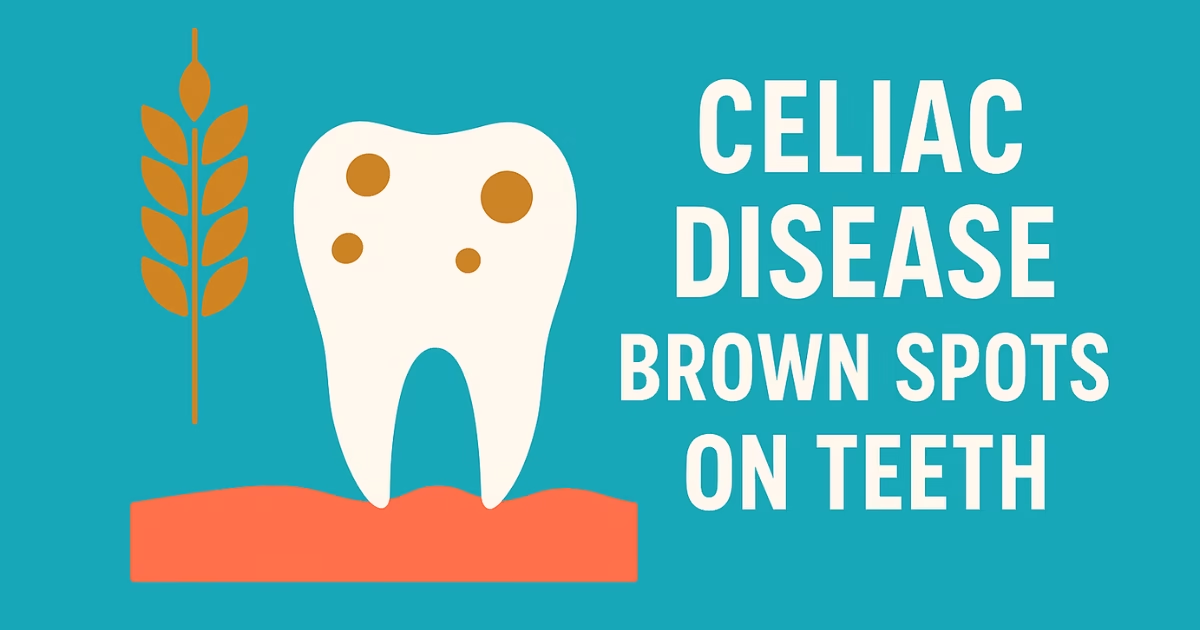Celiac disease is widely known for causing digestive problems, but its effects go far beyond the gut. One of the lesser-known symptoms can actually show up in your mouth. That’s right—your teeth might be giving you clues. Among these signs, celiac disease brown spots on teeth stand out as a potential red flag. These spots aren’t caused by cavities or poor hygiene. Instead, they often result from enamel defects tied to the body’s reaction to gluten. What’s more surprising is that dentists sometimes notice these changes before doctors do. Spotting them early can make a huge difference, especially in children. In many cases, these brown marks are the first visible hint of an underlying autoimmune condition. This article takes a deep dive into how celiac disease affects your teeth and what you can do if these brown spots appear.
What Are Celiac Disease Brown Spots on Teeth?
Brown spots caused by celiac disease aren’t just regular stains. They’re often the result of enamel not forming correctly during early childhood. This condition is known as enamel hypoplasia. The spots may appear brown, yellow, or even white, and are usually seen on the front teeth. What makes them unique is their symmetrical appearance—often showing up on the same teeth on both sides of the mouth.
Unlike surface stains from food, smoking, or coffee, these spots come from within the tooth. That means brushing or whitening products won’t remove them. They are permanent signs that something affected the teeth while they were developing. In many cases, this damage is linked to undiagnosed or untreated celiac disease. These brown marks can impact both baby and adult teeth, especially if the child had gluten exposure during enamel formation.
What Causes Brown Spots on Teeth in Celiac Patients?
Celiac disease affects the body in more ways than most people think. One of the causes behind celiac disease brown spots on teeth is malnutrition. When someone with celiac eats gluten, their immune system attacks the small intestine. This attack damages the lining and makes it hard for the body to absorb important nutrients like calcium, vitamin D, and phosphorus.
These nutrients are key when it comes to forming healthy teeth. If the body doesn’t get enough of them—especially during childhood when teeth are developing—the enamel can come out weak or discolored. In many cases, brown spots form because the enamel didn’t finish developing properly.
Another cause is the autoimmune response itself. Even without clear stomach problems, celiac can silently affect growing teeth. This is why some people show dental signs of celiac even before they have gut symptoms.
Other Dental Symptoms of Celiac Disease
Brown spots aren’t the only way celiac disease affects your teeth. There are several other dental issues tied to the condition. One of the most common is enamel hypoplasia, where the outer layer of the tooth is thin, weak, or patchy. This can lead to sensitivity, pain, or a greater risk of cavities.
Some people might notice:
- White, yellow, or brown discoloration
- Small grooves or pits in the teeth
- Teeth that look translucent or oddly shaped
- Increased wear or chipping
These signs are often symmetrical. That means if one tooth has a defect, the same tooth on the other side probably does too. This pattern helps dentists spot the difference between normal dental issues and those caused by something deeper—like celiac disease.
Other oral problems may include dry mouth, swollen gums, or frequent mouth ulcers. These are not caused by enamel damage, but they are still related to the immune system’s reaction to gluten.
How Dentists Help Detect Celiac Disease Early
Believe it or not, your dentist might be the first person to notice signs of celiac disease. Since brown spots and enamel defects often show up in the mouth before other symptoms appear, a trained eye can make a big difference.
Many dentists are trained to spot the patterns linked to celiac disease brown spots on teeth. If they see discoloration, enamel problems, or a combination of other oral signs, they might suggest that you talk to a doctor. This is especially true in children, where early detection can help avoid years of suffering.
Dentists might also ask questions about diet, stomach issues, or family history. If celiac is suspected, they can’t diagnose it—but they can start the conversation and point you in the right direction for testing. That makes regular dental checkups more important than ever.
Diagnosing Celiac Disease Through Dental Clues
While dental signs alone aren’t enough for a full diagnosis, they can raise a big red flag. Often, children with celiac disease brown spots on teeth don’t show classic gut symptoms like bloating or diarrhea. In these cases, teeth may provide the only early clue.
Once celiac is suspected based on oral signs, the next step is proper medical testing. This usually involves a blood test that checks for specific antibodies related to gluten. If the blood test is positive, a biopsy of the small intestine might follow to confirm the diagnosis.
Early diagnosis is important. If left untreated, celiac can lead to bone loss, fertility problems, or even certain cancers. Catching it through dental signs can lead to a healthier life and better outcomes overall.
Treatment for Celiac Disease Brown Spots on Teeth
The first step in treatment is managing the root cause: celiac disease itself. This means starting a strict gluten-free diet. While it won’t reverse the damage that’s already happened to the teeth, it can stop things from getting worse.
Once the diet is under control, dental care becomes the next priority. Depending on how severe the brown spots are, different treatments may be suggested. Some of the most common include:
- Dental bonding: Covers the spots with a tooth-colored material
- Veneers: Thin shells placed over the front of the teeth
- Teeth whitening: Can help if the discoloration is mild (though not always effective for internal stains)
Fluoride treatments and enamel-strengthening products can also help protect teeth from decay. The goal is not just to fix how teeth look, but also to protect them from further damage.
Can These Brown Spots Be Reversed?
Unfortunately, no. Once the enamel is damaged during development, it doesn’t grow back. Celiac disease brown spots on teeth are permanent because the enamel was never properly formed in the first place.
That said, they can be hidden or managed. Cosmetic treatments like veneers or bonding can make the teeth look much better. These options won’t heal the enamel, but they can help people feel more confident.
It’s also important to protect the rest of the teeth moving forward. A gluten-free diet helps stop the immune system from attacking itself, which protects overall health—including oral health. Preventing future problems is just as important as fixing what’s already there.
How to Protect Teeth if You Have Celiac Disease
If you’ve been diagnosed with celiac disease, or even if you just suspect it, there are several steps you can take to keep your teeth strong.
- Stick to a gluten-free diet. This is the most important step. It helps prevent new damage to both the gut and the teeth.
- Use enamel-friendly toothpaste. Look for products that contain fluoride or hydroxyapatite.
- Visit your dentist regularly. They can monitor for signs of damage and suggest treatments early.
- Watch children closely. If there’s a family history of celiac, pay attention to their teeth as they grow. Brown spots or enamel issues could be the first sign.
- Eat a nutrient-rich diet. Focus on foods high in calcium, vitamin D, and other minerals needed for healthy teeth.
The key is prevention. Once you know how gluten affects your body, you can take steps to protect your smile.
Personal Experience: A Common Story
Many people discover their celiac diagnosis after years of unexplained dental issues. One common story involves a young girl whose parents noticed brown spots on her permanent front teeth. They thought it was just staining or maybe a result of sugary drinks. But her dentist thought something else was going on.
After asking a few questions, the dentist suggested a medical checkup. Blood tests showed she had celiac disease—even though she didn’t have tummy problems. Starting a gluten-free diet helped her health in many ways, but her teeth still showed signs of past damage.
With dental bonding and regular care, she was able to smile confidently again. This story is just one example of how celiac disease brown spots on teeth can lead to life-changing discoveries.
Conclusion
Celiac disease brown spots on teeth may look small, but they can point to a much bigger problem. These brown marks are not caused by sugar or coffee—they’re a sign that something went wrong while the teeth were developing. Often, it’s celiac disease silently affecting the body without typical stomach symptoms.
By understanding this connection, people can catch the disease earlier and take action. Dentists play a key role in spotting the first signs, especially in children. Though the damage can’t be reversed, there are many ways to manage and improve the appearance of teeth through cosmetic care.
Most importantly, staying on a strict gluten-free diet protects your teeth and your whole body. If you or your child have unexplained brown spots on your teeth, don’t ignore them—they might just be your body’s early warning sign.

Hi, I’m Shafy Ali – a curious mind and passionate writer at Celiac Magazine. I cover a little bit of everything, from everyday tips and how-tos to deeper dives into topics that spark conversation. I enjoy turning research into readable, relatable content that informs and inspires. Whatever the subject, I aim to keep it clear, engaging, and genuinely useful.

